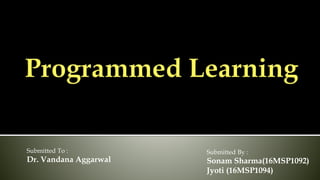
Programmed learning
- 1. Submitted To : Dr. Vandana Aggarwal Submitted By : Sonam Sharma(16MSP1092) Jyoti (16MSP1094)
- 2. Coined from principle of Operant Learning or Conditioning First started ‘programmed learning’ in 1943 by B.F. Skinner and his companions. B.F. Skinner published a paper entitled ‘Science of Learning and art of Teaching’.
- 3. “Programmed instruction is the process of arranging the material to be learned into a series of sequential steps that is from known to unknown.” ------ Smith and Moore “Programmed learning is a method of designing a reproducible sequence of instructional events to produce a measurable and consistent effect on behavior of each and every acceptable students.” ------ Susan Markle
- 4. Principle of Small Steps Principle of Active Response Principle of Immediate Reinforcement Principle of Self –Pacing Principle of Self Evaluation
- 5. To help the students for learning by doing. To provide the situation to learn at his/her own speed. To help the students to learn without the presence of teacher. To present the mater in a logical manner. To study himself. To evaluate himself. To compare his/her answer with the key .
- 6. Types of Programmed Learning Linear programming Branching programming Mathetics
- 7. o Developed by B.F. Skinner and his associates. o Subject method will be divided into very small steps each of which is called as frame. o In each frame, the student to do something. o After giving the answer for the question immediately, he can check whether his answer in correct or wrong. o Straight line – single track
- 8. Linear Arrangement Small Steps Controlled Responses Active Responding Immediate Feedback Prompting Self- Pacing Simple Mechanism Minimum error
- 9. Construct response Multiple choice type Conventional chaining Skip linear Criterion frames Egrule system Rulge system
- 10. Merits : Immediate knowledge Strengthen responses Division of frames Demerits : Lack of Motivation No Freedom of choice No development of discriminative power No student centered No specific role of teacher Difficulty in finding background Guess work
- 11. Developed by Norman, A. Crowder (1960). In this method the subject should select the answer for the question(Objective Type). If subject’s answer is correct he will lead to the next frame. If subject’s answer is wrong he will lead to the remedial frame. After the remedial frame he will directed to the main frame.
- 13. Based on traditional tutorial method Larger frame Multiple choice questions Alertness of learners Easier to develop frames Teaching and instruction Psychological and social motivation Meaningful units No hinderance by errors
- 14. Principle of Exposition Principle of Diagnosis Principle of Remediation
- 15. Merits : Individualised instruction Larger frames Alertness of learning Development of creativity Programmed text & motivation Demerits : Guessing Difficulty in multiple choice questions Difficulty in arranging the Branching Programme Not Suitable for small children Costly No suitable feedback Programmer’s imagination
- 16. Developed by Thomas F. Gilbert. “Mathetics is defined as a systematic application of reinforcement theory to the analysis and construction of complex repertoires which represent the mastery in subject matter.” Based on connectives theory of learning. Reverse chaining approach.
- 17. Mastery step Motivation Reverse chaining Stimulus & response Prompting Prescription
- 18. ¤ Principle of Chaining ¤ Principle of Discrimination ¤ Principle of Generalization
- 19. Merits : More meaningful and valid. Easy and significant. Wide range of applicability. Complete training system Demerits : Main emphasis is on mastery of the content rather than changes in behavior of the learner. Retrogressive chaining of stimuli. Difficult to develop retrogressive learning package.